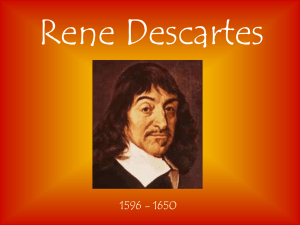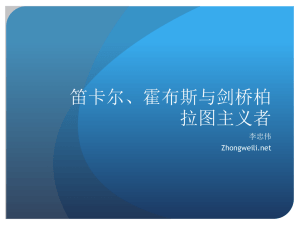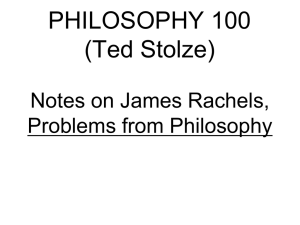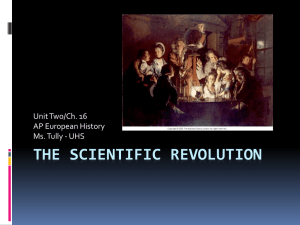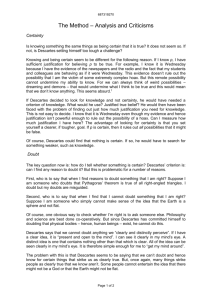Benefit of the Doubt
advertisement
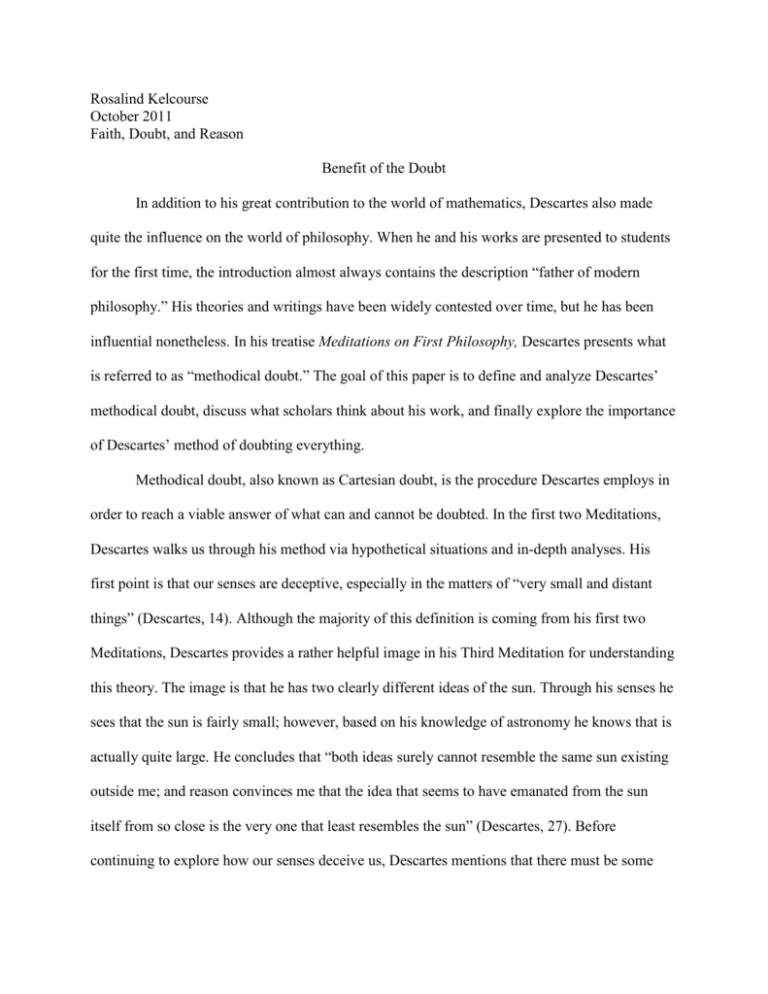
Rosalind Kelcourse October 2011 Faith, Doubt, and Reason Benefit of the Doubt In addition to his great contribution to the world of mathematics, Descartes also made quite the influence on the world of philosophy. When he and his works are presented to students for the first time, the introduction almost always contains the description “father of modern philosophy.” His theories and writings have been widely contested over time, but he has been influential nonetheless. In his treatise Meditations on First Philosophy, Descartes presents what is referred to as “methodical doubt.” The goal of this paper is to define and analyze Descartes’ methodical doubt, discuss what scholars think about his work, and finally explore the importance of Descartes’ method of doubting everything. Methodical doubt, also known as Cartesian doubt, is the procedure Descartes employs in order to reach a viable answer of what can and cannot be doubted. In the first two Meditations, Descartes walks us through his method via hypothetical situations and in-depth analyses. His first point is that our senses are deceptive, especially in the matters of “very small and distant things” (Descartes, 14). Although the majority of this definition is coming from his first two Meditations, Descartes provides a rather helpful image in his Third Meditation for understanding this theory. The image is that he has two clearly different ideas of the sun. Through his senses he sees that the sun is fairly small; however, based on his knowledge of astronomy he knows that is actually quite large. He concludes that “both ideas surely cannot resemble the same sun existing outside me; and reason convinces me that the idea that seems to have emanated from the sun itself from so close is the very one that least resembles the sun” (Descartes, 27). Before continuing to explore how our senses deceive us, Descartes mentions that there must be some things which cannot be doubted even though they come from our senses. He describes a scene in which he is dressed, sitting by the fire, and holding the piece of paper on which he is writing. He says that the only way he could begin to doubt whether his body and hands were his own would be if he were insane (Descartes, 14). At this point, although we cannot fully rely on our senses for accuracy about things like the size of the sun, we can still be certain that our hands and bodies are our own. The next level of Descartes’ method is entirely focused on dreams. When we are dreaming, our senses perceive things that seem quite real and concrete but are actually no more than ideas in our head. No matter how real these things seem to us at the time, upon waking we realize that none of it was. Dreams can be extremely intricate and consist of vivid sensory details like smells and sounds as well as incredibly lifelike experiences. Nonetheless, we are still lying in bed, experiencing those things only in our minds while our body rests. At this point in doubt, very little seems feasible. Be that as it may, Descartes makes the point that, “whether I am awake or asleep, two plus three make five, and a square does not have more than four sides” (Descartes, 15). Even when we let our subconscious take over and fill our mind with dreams or we venture to believe that we are not what we seem, simple laws of arithmetic and geometry remain certain. In the final stage of his method of doubt, Descartes suspends all he knows and believes to be true. He creates a hypothetical world where instead of there being a “supremely good God” there is an evil force (Descartes, 16). Descartes describes this force as “an evil genius, supremely powerful and clever, who has directed his entire effort at deceiving me” (Descartes, 16). Descartes continues to suspend what we would consider reality in order to reach his goal of knowing something for certain, because up until now he has doubted everything. The entirety of the Second Meditation consists mainly of Descartes trying to arrive at a final truth. He first questions what he is if he is without a body or senses, then what the distinction between body and soul is, and then thinking in and of itself. He goes back and forth between possible certainty and likely doubt until he finally reaches a conclusion. “Here I make my discovery: thought exists; it alone cannot be separated from me. I am; I exist – this is certain” (Descartes, 19). Descartes’ method of doubting everything seems quite pessimistic at first, but upon further inspection it is actually a valid attempt at finding something to be true beyond all doubt. He doubts everything because he believes it will reveal what is certain. Throughout his method, Descartes cleared his mind of more and more things as he went on, both concrete and abstract. The result was clarity. By doubting everything, Descartes is trying to achieve this clarity. When all questionable things are removed, all that will remain is the truth. If this was in fact Descartes’ goal, he accomplished it quite successfully; he found his one truth. Cogito ergo sum. Descartes’ Cogito has been a topic of dispute for centuries, and certainty he achieved led to much interest in his writings. Scholars have been analyzing his works and conversing with each other about the validity of his conclusions and methods. Some have argued in his favor, but most have argued against him. Descartes’ method of doubt seems to be a favorite topic amongst Cartesian scholars and those who disagree with it have just as much to say. One point that is often held against him is that he does not get to his conclusion in a fully realistic way. It seems impossible to try to experience reality as a dream, let alone wholly believe it. According to one scholar, Descartes “proceeds to prove by argument that the world is a dream” (Sibajiban, 108). Sibajiban then cites Descartes’ assertion that there are no definitive ways for distinguishing being awake from dreaming. This scholar finds fault here not in the conclusion so much as in the argument. He discusses that, while it is understood that Descartes isn’t literally suspending his belief in everything, the simple act of using that argument is completely illogical. Sibajiban then shows us that even Descartes himself realizes how absurd his universal doubt is: “I ought indeed to reject as hyperbolical and ridiculous all the doubt of these past days, more especially that regarding sleep, as being indistinguishable from the waking state. How marked, I now find, is the difference between them!” (qtd. in “Descartes’ Doubt, 108-109). Additionally, as in most analyses of Descartes work, Sibajiban calls attention to the circular argument which announces itself with gusto. Our scholar puts it as simply as possible: The cogito can be true only if the doubt is true, but as Descartes asserts that the doubt is false, the cogito is false. But if the cogito is false, then it cannot restore the truths which have been doubted before, i.e., the doubt is true. Thus, if the doubt is true, then the cogito is true, and therefore, the doubt is false; if the doubt is false, the cogito is false, and therefore, the doubt is true. (109) This circular reasoning, which is also apparent in Descartes’ argument for the existence of God, is often referred to as the Cartesian circle and has been one of the most notable aspects of Descartes’ work. Sibajiban provides us with a thorough analysis of the flaws in Descartes’ method of doubt. This can only be amplified through the exploration of another scholar’s work. Paul Ricoeur, a well-known and highly distinguished philosopher of the twentieth century (“Paul Ricoeur”), provides an in-depth analysis of the inconsistencies and shortcomings of Descartes’ Cogito and method of doubt. In his article “The Crisis of the Cogito,” Ricoeur often refers to the “radicalness” of Descartes’ notions and assertions. This is not without great consideration of Descartes’ intentions. The first problem Ricoeur addresses is how this method of doubt goes against the grain of common sense: The fact that all reality can be suspected of being no more than a dream, that the simple truths of geometry and arithmetic can be held to be uncertain, that the distinction between seeming and being vacillates - this threefold questioning is incomparable to the localized doubts that stand out against the backdrop of some sensible, scientific or metaphysical certainty, which itself is uncontested in the moment of doubt. (58) This is a completely valid point. Although it can be understood that Descartes’ intentions are to clear his mind of all that could be false in order to reveal an ultimate truth, Ricoeur makes a strong argument that regardless of Descartes’ intentions, the method he uses to achieve his desired results is radical and greatly lacking in common sense. This argument is not unlike the one offered by the previous scholar. The other topic stressed by Ricoeur is what “I” actually means in Descartes’ method. At first the I is Descartes as a concrete being, sitting by a fire and fully aware of his surroundings. As he progresses through the three tiers of his method, the I becomes one which is “as metaphysical or hyperbolical as doubt itself…” (Ricoeur, 58-59). Here, Ricoeur is implying that not only are Descartes’ notions about the self radical, but his complete suspension of all reason is just as dramatic. Ricoeur’s essay eloquently exemplifies the common thought that Descartes’ method of doubt and realization of the Cogito are ridiculous notions and should not be taken as a legitimate way to arrive at an ultimate certainty. Based on the articles examined and research conducted, as well as the above analysis of Descartes’ Meditations on First Philosophy, one may find one’s self going back and forth between knowing and doubting, much like Descartes himself in his Second Meditation. The first thing most people learn about Descartes is that he was famous for saying, “I think, therefore I am.” It seems quite obvious initially, but in order to give him the benefit of the doubt and to employ some optimism, it can be interpreted differently. Instead of seeing it as an obvious statement that seemed to go without saying, it can be taken as something more along the lines of Socrates’ famous quote: “The unexamined life is not worth living.” While it is widely accepted that this is not what Descartes meant, it is interesting to look at things from a different perspective. After the above analysis of Descartes as well as many scholarly articles about the Cogito, it seems slightly naïve to alter the accepted significance of his work. Regardless, it’s refreshing to think outside the box of what one has been taught and give new meanings to things. As can be gathered from the scholarly articles and basic analysis, Descartes was generally considered to be an incredibly influential philosopher, but not to be taken seriously. To a student uneducated in that area, it may seem a little harsh. For a man who worked and thought as hard as Descartes did, one would think it would be common sense to hold him in high esteem. Of course, Descartes’ works are certainly appreciated. Although some of it appears illogical, especially to scholars, a good deal of it is accepted. For example: Descartes’ contributions to mathematics, such as the rule of signs and analytic geometry, are widely used and launched further exploration of mathematical methods. After reading the works of great scholars such as Paul Ricoeur and studying Descartes’ works, it is more understandable why many philosophers and scholars don’t take him seriously. His method of doubting everything seems quite radical and completely lacking in common sense, although it can be understood what he is trying to do. An interesting comparison of Descartes’ thinking lies in the Buddhist spirituality. Although he can (and has been) described as the “total anti-Buddhist”, it could be thought that the action of doubting everything was a somewhat Buddhist thing to do. A major facet of Buddhism is to clear the mind of unnecessary things in order to achieve an inner peace. Although this isn’t exactly what Descartes is doing, or even close, this analogy is certainly worth mentioning. As far as the notion that he is the “total anti-Buddhist” goes, it is quite the accurate description. There is an aspect of Buddhism known as the “Three Marks of Existence.” This set of characteristics exemplifies Buddhism and highly contrasts with Descartes’ notion that the only thing that he can be completely certain of is his existence. Of the three characteristics, the one that provides the most contrast is the notion of the non-self. This notion basically states that there is no self, physical or otherwise. The idea of “self” is an illusion (one of the five poisons in the Mahayana tradition of Buddhism). Clearly, this is the exact opposite of Descartes’ conclusion that the only thing he knows for certain is that he exists. As the Buddha once said: “Where self is, truth is not. Where truth is, self is not” (Carus). Though it seems to have become common practice to shrug off Descartes’ methodical doubt as an overdramatic attempt at reaching an ultimate truth, it is still important to understand his methods. Descartes has had a substantial influence on modern philosophy, and by learning about his methods and ideas we can further understand why he has made such and impact. Through studying and analyzing methodical doubt we can get a greater understanding of our own reality. It is important to exercise our minds with philosophical vigor in order to have a generally enlightened, or at least moderately educated, outlook on life. Contemplating questions like the ones posed by Descartes can make the experience of life so much more powerful and even fulfilling. For these reasons, we can be grateful that Descartes thought, for had he not, he would never have existed. Works Cited Carus, Paul. "Enlightenment." The Gospel of Buddha. LaSalle: Open Court, 1894. Mountain Man. Web. 31 Oct. 2011. Dauenhauer, Bernard, and David Pellauer. "Paul Ricoeur." The Stanford Encyclopedia of Philosophy. Summer 2011. Web. 29 Oct. 2011. Descartes, René. Meditations on First Philosophy. Indianapolis: Hackett, 1993. Print. Ricoeur, Paul. "The Crisis of the Cogito." Synthese 106 (1996): 57-66. JSTOR. Web. 30 Oct. 2011. Sibajiban. "Descartes' Doubt." Philosophy and Phenomenological Research 24 (1963): 106-16. JSTOR. Web. 28 Oct. 2011. "The Three Basic Facts of Existence: III. Egolessness (Anatta)." Access to Insight. Ed. Ñanamoli Thera. 5 June 2010. Web. 31 Oct. 2011.
